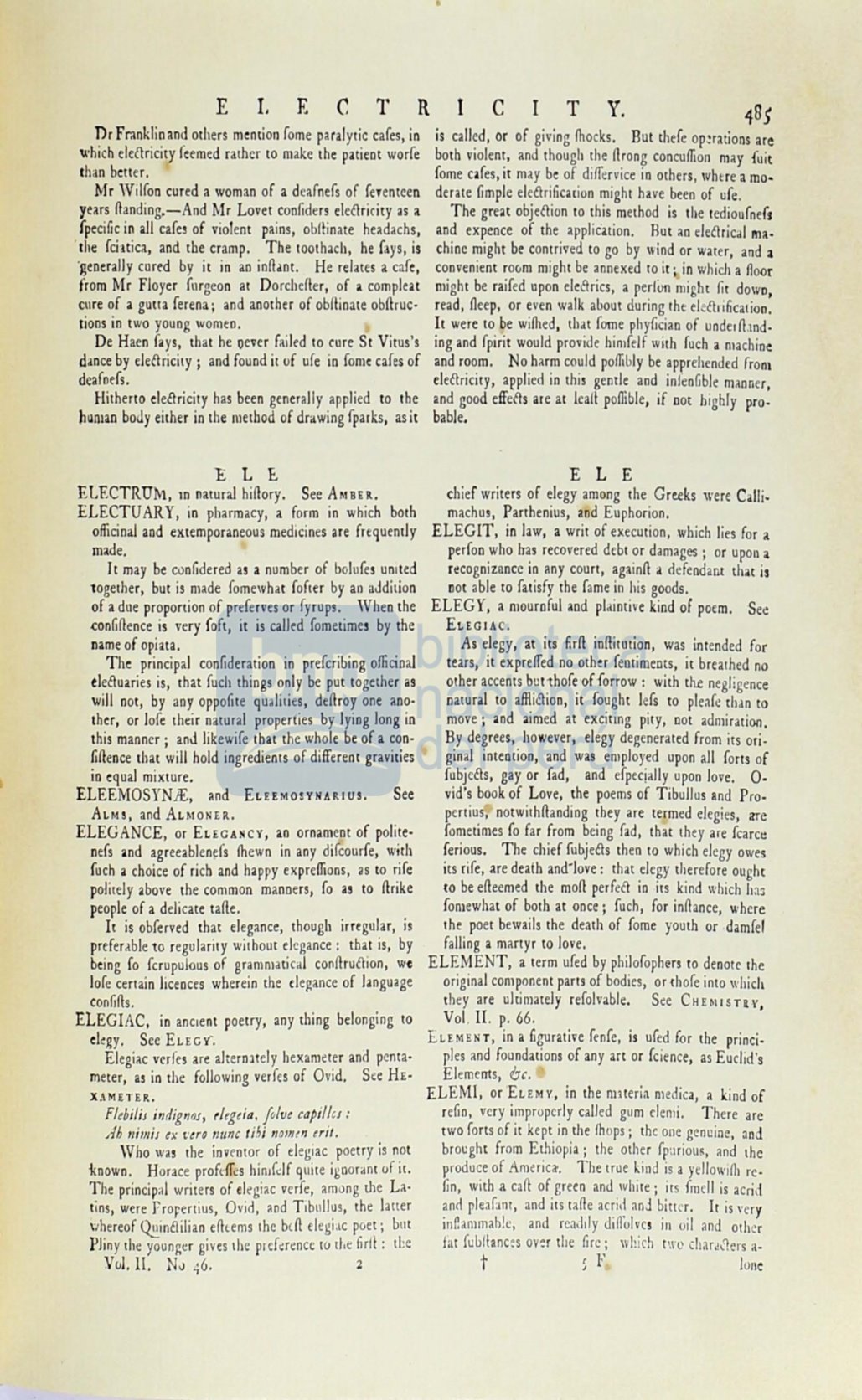

E
1.
E
T
R
e
T Y.
4B
s
Dr Franklinand others mention fome paralytic cafes, in
...hieh elearieity feemed rathcr tO make the patient worfe
Ihan better.
Mr Wilfon cured a woman of a dcafnefs of fe,entcen
years lIanding.-And Mr Lovet confiders ele{lricity as a
fpecific in all cafes of violent pains, obt!inate headachs,
Ihe fciHica, and tbe cramp. The toothaeh, he fays, is
'generally cured by it in ao
inll.nt.He relates a cafe,
from Mr Floyer furgeon at Dorehefler, of • complm
cure of a gutla ferena; and another of obllioate obílruc·
lions in two young women.
De Hacn fa ys, that he oever failed to cure St Vitus's
d.nce by ele{lricity; and found it uf ufe in fome eafes of
deafnefs.
Hithmo e1e{lricity has been generally applied to the
human body either in the metbod of d..wing fparks, as it
E L
E.
El.F.CTRUM,
lO
natural hiílory. See AMBER.
ELECTUARY, in pharmacy, a form in which both
ollieinal aod extemporaneous medicines are frequently
rnade.
It
may be confidered as a number of bolufes uOlted
logether, but is
m.defomewhat fofler by an aJdilion
of adue proponion of prefen'es or fy rups. \Vhenthe
confillence is very foft, it is ealled fomelimes by the
nameof opiata.
The principal confideration in prefcribing o/licinal
e1e{luaries is, that fuch things only be put together as
",ill oot, by any oppofite qualities, deílroy one .no·
ther, or lofe lhtir natural propenies by Iying long in
this manner; anJ likewife lhal lhe whole be of a con·
fiílence that will hold ingredients of dilferent gravities
in equal mixture.
ELEEMOSYNft:, .nd ELEEMOSVNARlUS. See
ALMs, and ALMONtR.
ELEGANCE, or EUGANCV, an ornament of polite.
nefs and agreeablenefs Ihewn in any difcourfe, with
fueh a choice of rieh and happy expreOions, as to rife
polilely aboye the common manoers, fo as to ílrike
people of a delicate tafle.
Ir
is obferved ma! eleganee, though imgular, is
prefer_bleto regu larity Wilhout eleganee: that is, by
being fo fcrupulous of grammatical conílru{lion, we
lofe eemin lieeoees wherein the rleganee of language
confills.
ELEGIAC, in anelCnt poetry, any thing belonging to
e1'gy. See EUG\".
Elegiae verfes are alternmly hexamm r and penta·
meter, as in the following verfes of Ovid. See HE'
X.\ ME' ·ER.
FI,bit;, indignoJ, ,hgeia. foIv, capillCJ :
Ah
1J;1/IÍ!
ex t'ero
'ltme
t¡bj
nOIJun
eril.
\Vho was the in,entor of elegíae poetry is not
bown. Horaee profdfes hin,fdf quite ignoranI of íl.
The prinei p,1wrilers of elegiae .erfe, amung the La·
tíns, were Fropenius, Ovid, aod Tlbnllus, lhe hller
",hereof
~in{lilian
ealemS lhc blll
elegi.lep~et ;
bm
1'Iiny the younAcr gives lhe prefértneC
10
tI,é
(¡dI : lhe
Y~1.
11.
N~
.;6.
2
is ealled, or of giving Ihoeks. But Ihefe op!rations are
both violent, .nd though the IIrong eoncuOion may fuit
fome cafes, it may be of dilferviee in olhers, whtreamo–
derate fimple ele{lrification mighl have been of uCe.
The great obje{lion to this method is the tediouCnees
and expence of the applie·ation. Hut anele{lric.1ma.
chinc might be
eonlri.edto go by wind or water, and a
con.enient
ro~m
might be annexed lO it; in whieh a noor
might be raifed upon e1e{lries, a pedimmigh l fit dowo,
read, fleep, or even walk aGout during lht ele{llificalion.
lt
were lO be wiOled, that fome phyfieian of undedhnd.
ing and fpirit would pro.ide himfelf with fueh a Olaehine
and room. No harm eould po/flbly be apprehended froOl
e1e{lrieilY, applied in this gentle and inJenfible manner,
and good e!Fe{ls are at leal! poOible, if DOt highly pro.
bable.
E L E
chief writers of elegy among the Greeks were Calli.
maehus, Panhenius, and Euphorion.
ELEG IT, in law, a writ of exeeutíon, whieh lies for a
perfonwho has reeo.ered debl or damages; or UpOIl a
reeognizonee in any coun, againa
~
nefendaOl that il
not able tO fa.tisfy the fame in his goods.
ELEGY, a ",ournful and pl.iOlive kind or poem. Sec
ELEGIA C.
As e1egy, at its firn innitulÍon, was intended for
tms, it exprelfed no
oth~r
fentimeots, il breathed no
olheracceOls bct1hofe of forrow : with ttu: negligence
natural to alRi{lion, it Cought lefs to
pleaf~
thAn to
move; and .imed at exeiung pily, not admiralion.
By degrees, hoY/ever, elegy
de~enerated
from ilS ori.
ginal in!Colion, and was employed upon all fom of
fubj e{ls, gay or fad, and efpec¡ally upon love. O.
vid's bookof Love, the poems of 1"ibullus Rnd Pro.
pertius, notwilhllanding they are termed elegies, :rre
fometimes fo far from being fad, lha! lhey are fearee
ferious. The chief [ubje{ls then tO whích e1egy owes
its rife, aredealh and-Iove: tha! e1egr therefore ought
to be elleemed the moll perfe{l in ilS kind \\'hich
ha~
fOOlewhat of both at once; fuch, for inllanee, where
the poet bewails the death of fome youlh or damrel
falling a manyr to lo.e.
ELEMENT, a mm ufed by philoCophers to denote lhe
original eomponent pans of bodies, or thofe iOlO \\'hieh
they are ultinmely refolvable. See CH
H\I
s
Ti
Y,
Vol. 11.
p.
66.
ELEM ENT, in a figurative fenfe, is uCed for the princi.
pies and foundations of any art or feienee, as Eudid's
Elements,
&c.
ELEM1, or ELEM
Y,
in Ihe nllteria medica, a kind of
refin, vcry improperly called gllm c1eOli.
There are
tWO fons of it kept inthe (hops; theolle gencine, and
brocght fromElhiopia; Ihe olher fpurion" aod lhe
produceof Ameriew.
The Irue ki"d is a yellow,Ol re.
fin, w¡lh a call of green and \Vhite ; ilSCmell is aCrid
aocl pleaf'''l, and ilSt. lle .erid anJ binrr.
It
is very
illflammah!c, and rea.ldy
diOul.csin oil and olher
(:(\
fuGl!aoc~s
oy:r the fi re; which l\\'O
char¿,~ers
a.
tIlo'
10lle
















